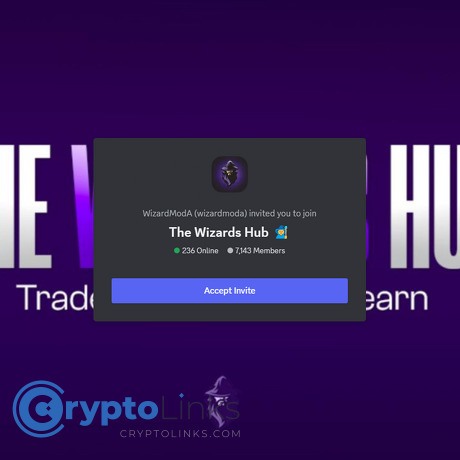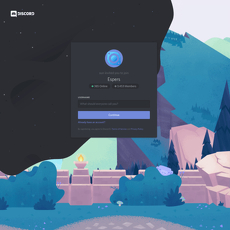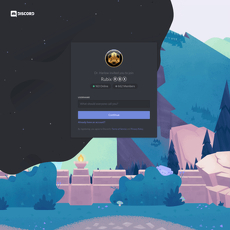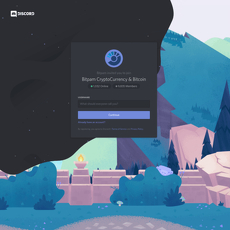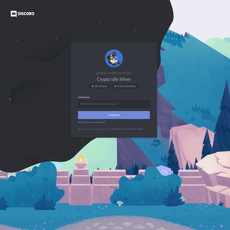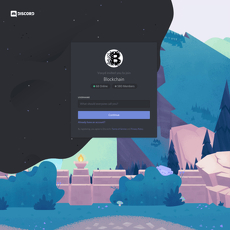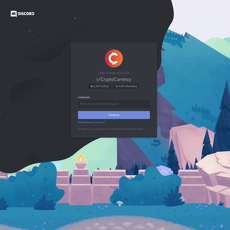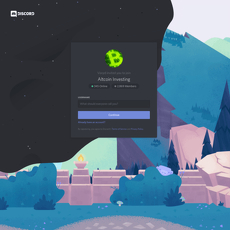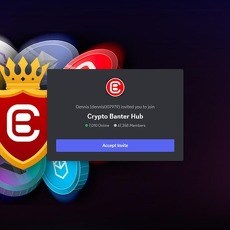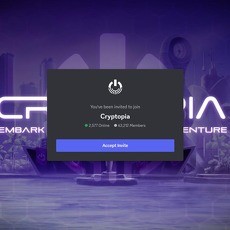The Wizards Hub Review
The Wizards Hub
discordapp.com
The Wizards Hub Review Guide: Everything You Need To Know + FAQ
Ever jump into a crypto Discord, only to get hit with spam, confusing verification steps, and “alpha” that feels like guesswork?
I joined The Wizards Hub to separate signal from noise and show you exactly how to get in, what to expect, and how to stay safe while you look around. If you want a fast, honest walkthrough—without wasting hours—keep reading.
The problem most crypto Discord users face
Let’s be real: lots of crypto servers are chaotic. The biggest pain points usually show up right away:
- Noise overload: Dozens of channels, constant pings, and content that doesn’t match your interests.
- Verification confusion: Bot prompts, role menus, and rules scattered across multiple channels.
- DM scams: “Team members” messaging you with fake mints or urgent wallet requests.
- Low-quality “signals”: Hype posts with no data, no context, and no accountability.
- Dead or off-topic chats: Inactive rooms or meme spam where you expected research and tools.
These aren’t just gut feelings. Industry reporting has repeatedly flagged scam tactics in crypto communities, especially through platform DMs and fake “support” outreach. Research from sources like Chainalysis shows scams remain a persistent share of crypto-related crime, and platform safety teams (see Discord’s Safety Center) explicitly warn against message-based phishing. The pattern is predictable—bad links, fake giveaways, impersonation—so you’ll want simple habits to filter risk from the start.
Quick rule to remember: if it’s not posted in the server’s official announcements channel, treat it as unverified—especially if it lands in your DMs.
What I’ll help you with
You don’t need another sales pitch. You need a clear plan. Here’s what you’ll get in this guide:
- How to join fast: Use the invite discord.com/invite/6sPbk83USp on desktop or mobile without hitting common roadblocks.
- What to expect inside: A quick tour of how servers like this are usually structured, so you can find the value channels quickly.
- How to cut noise: Easy notification settings and role tips that keep your feed clean and useful.
- Safety must-dos: The practical steps that block 90% of scams before they start.
Who this is for
- New to Discord: You want a clean entry path, not a maze of bots and pop-ups.
- Active traders: You need timely updates and smart filters, not 100+ pings a day.
- Web3 builders and researchers: You’re looking for focused discussions, tools, and collaboration.
- Quiet lurkers: You prefer curated feeds and a simple way to stay in the loop.
What you’ll walk away with
- Step-by-step joining guide: Desktop and mobile, explained simply.
- A quick server game plan: Which areas usually matter most and how to spot them fast.
- Noise control: Notification presets and role choices that keep distractions low.
- Security basics that work: How to avoid DM traps, fake “mods,” and bad links.
- Simple FAQ: Short answers so you’re not guessing as you get started.
So, is The Wizards Hub actually worth your time—and who’s getting the most value from it right now? Let’s look at what it is, who it attracts, and how the day-to-day activity feels inside.
What Is The Wizards Hub?
The Wizards Hub is a crypto-focused Discord that feels like a working room, not a hype pit. On any given weekday, I see traders posting quick reads on market structure, builders swapping notes on tooling, and NFT collectors flagging real mints instead of “maybe, someday” PDFs. It attracts a mixed crowd—active traders, DeFi tinkerers, web3 devs, NFT hunters, and newcomers who want curated updates without being glued to a screen.
The pace is steady. Mornings lean macro and news-heavy, afternoons turn tactical (orderflow, airdrop chatter, new contracts to watch), and evenings settle into Q&A and learning threads. It’s not quiet, but it’s not chaos either. You’ll find signal if you visit with a goal: “What moved today?” “What’s on-chain that isn’t priced in yet?” “What should I study this week?”
“In crypto, signal-to-noise is an edge. Keep your curiosity sharp and your notifications sane.”
Purpose and positioning
The server aims to be a practical hub for discussion, timely news, hands-on research, and light tools—basically a place to think and act faster without getting baited by every pump tweet. Compared to the typical crypto servers I’ve reviewed, it skews toward organized info and measured takes, not “100x or bust” noise.
- Discussion with receipts: Market opinions usually come with a chart, a link, or an on-chain tx. That’s the difference between speculation and a plan.
- News and research: Fast headlines and smart summaries so you don’t need 20 open tabs. When something breaks, context follows.
- Tools and “alpha” (with realism): You’ll see watchlists, on-chain hints, and frameworks. It’s useful, but it’s not a copy-trade factory—expect homework.
This positioning works. Research on online communities shows that active moderation and structured knowledge-sharing increase learning and retention over time. You can feel that intent here: fewer empty hot takes, more “here’s my process.”
Culture and moderation
The tone is helpful and fairly no-nonsense. Rules are clear: no spam, no cold DMs, vet links, respect the thread topic. I noticed staff online across common hours, and they’re quick to cool down off-topic debates or remove dodgy links. A sketchy “airdrop” URL got nuked fast when I saw it—exactly what you want.
- Staff presence: Mods and helpers are visible and responsive. Questions get answers, not sarcasm.
- Spam handling: Link filters and basic gating keep raids and throwaway shills out. That alone raises the signal.
- On-topic flow: Threads and channel scopes are respected, which keeps valuable info from getting buried.
Discord’s own safety guidance highlights how verification and role-based access reduce spam and scams. The vibe here tracks that playbook: verify once, pick your focus, and you’re in a cleaner lane than most public crypto servers.
“Strong communities are built on receipts, not vibes.”
Who will get the most value
- Active traders: You’ll appreciate the quick market reads, on-chain nudges, and the way people justify entries and exits. It’s a good second screen.
- Learners: If you’re building knowledge, you’ll find FAQs, patient replies, and threads that explain the “why,” not just the “what.” Give it 10–15 minutes a day and you’ll see compounding gains.
- Web3 builders: Practical chatter about tooling, contracts, and infra. You can float a problem and usually get a solid nudge in the right direction.
- NFT collectors: Not a mint-shill circus—expect watched collections, marketplace reads, and realistic talk about liquidity and risk.
- Curated lurkers: If you like to read more than chat, the announcements and pinned summaries are enough to keep you sharp without constant scrolling.
If you want copy-paste signals or zero reading, it won’t fit. If you want context, prompts, and a cleaner feed than the average crypto Discord, it’s a match.
Curious but short on time? I kept the next part super simple—want the exact, 60-second steps to join without tripping on verification or notification spam?
How To Join The Wizards Hub
You don’t need to wrestle with Discord to get in. If you want to join fast, avoid spammy dead ends, and set yourself up right from the first click, follow this. I’ll keep it simple and practical.
“Trust nothing, verify everything.” In crypto and in Discord, that mindset saves time and keeps your wallet safe.
What you need to join Discord (the basics)
Before you hit the invite, make sure the basics are covered. It takes a couple of minutes and it’s worth it.
- Discord app or web: Use the desktop app for the smoothest onboarding, or the web at discord.com/login.
- Free account: Create one or log in. New? Register at discord.com/register and confirm your email.
- Phone number (optional but helpful): Some servers require phone verification to keep bots out. Add it under User Settings > My Account.
- Two-Factor Authentication (2FA): Turn it on under User Settings > Password & Authentication. A large-scale Google study has shown that adding 2FA blocks most automated and phishing takeovers across platforms—worth the extra 30 seconds.
Desktop steps
Here’s the fastest route in if you’re on Windows, macOS, or using the browser.
- 1) Open Discord and log in.
- 2) Click the “+” icon in the left sidebar.
- 3) Choose “Join a Server.”
- 4) Paste the invite.
- 5) Hit Join. If your browser prompts you to open the app, accept it.
Quick fixes if something’s off:
- “Invite Invalid”: Re-check the link for typos. If you’re in a VPN-heavy setup, try disabling the VPN and retry.
- Endless loading: Quit and relaunch Discord, or join via the web at discord.com/channels/@me then paste the invite again.
- Already joined but can’t see anything: Look for a #rules or #start-here channel—many servers gate content until you accept rules or verify.
Mobile steps
On iOS or Android, it’s basically the same flow with different taps.
- 1) Open the Discord app and log in.
- 2) Tap the hamburger menu (≡) on the top-left to open the server list.
- 3) Tap the “+” icon.
- 4) Choose “Join a Server.”
- 5) Paste the link and confirm.
Mobile tips that save headaches:
- If you get a blank screen after joining, pull down to refresh, then look for a #verify or #rules channel.
- On older app versions, the verification button may sit behind a prompt—scroll the channel to the top once to reveal it.
Verification and first-time setup
Most crypto servers use basic screening to keep bots and scammers out. It’s normal. Here’s what to expect and how to breeze through it.
- Member Screening: You may see a panel with rules. Hit Acknowledge or Accept to unlock the server.
- Captcha or bot check: Common patterns include:
- React with an emoji (e.g., click ✅) to verify.
- Press a “Start Verification” button and complete a captcha in your browser.
- Type a command like !verify in a specific channel and follow the bot’s prompt.
- Role selection: Some servers let you pick interests to unlock relevant channels. Look for #roles or a message with buttons like Trading, NFTs, Builders. Pick only what you want to see to keep noise low.
- Notifications (be smart): Go to Server Settings > Notifications:
- Set Notification Settings to Only @mentions so you’re alerted only when tagged.
- Suppress @everyone and @here if you don’t want mass pings.
- Mute channels that aren’t relevant on day one. You can always unmute later.
- DM safety: In Privacy Settings for the server, disable “Allow direct messages from server members.” This cuts out unsolicited pitches—the number one source of Discord scams.
- Security snapshot: Strong password + 2FA + verified email = sturdy baseline. If a bot ever asks you to sign a wallet transaction to “verify,” that’s a hard no.
Common snags and how to clear them fast:
- “You must verify your email/phone”: Open User Settings > My Account, complete the confirmation, then re-open the server.
- Captcha opens but doesn’t finish: Try a different browser (Chrome/Safari) or switch off in-app browser to your default browser.
- New account throttling: Very fresh accounts sometimes face extra checks. Waiting a few minutes or adding a phone number usually resolves it.
Once you’re in and verified, the real question is simple: which channels are actually worth your first 10 minutes so you don’t drown in noise? I’ve got a short list and a smart starting routine next—want the signal without the scroll?
Inside The Server: Channels, Roles, Tools, And Events
Stepping into a new crypto Discord can feel like walking into a trading floor mid-session—alerts blaring, charts flying, and a dozen threads arguing about the next move. Here’s how I cut through the noise inside The Wizards Hub and turn day one into useful signal.
“Noise is the tax you pay for alpha. Your job is to lower the rate.”
Key channels to check first
Every well-run crypto server builds a backbone of channels that actually matter. Expect names to vary, but look for these patterns and use them exactly like this:
- Announcements / Updates — The heartbeat. Turn on “Only @mentions” and use the Follow button (if available) to mirror critical posts into your own quiet server so you never miss listings, collabs, or rule changes.
- Rules / Start-here / FAQ — Two minutes here save hours later. Skim verification, DM policy, link formats, and how roles work. If there’s a “How to use this server” post, read it. It’s the map.
- Market Chat / Trading-Desk — Fast-moving commentary, chart screenshots, and thesis fragments. Use threads to keep one idea per conversation. If a thread pops, bookmark it or copy its link into your notes.
- Research / On-chain Watch — Higher signal, fewer memes. Look for wallet breakdowns, tokenomics notes, and post-mortems. Ask for a TL;DR if a write-up is long—good communities welcome summaries.
- Builders / Dev / Tools — If you ship, this is gold. People share repos, contract snippets, or gas optimizations. Lurkers still win here: you learn how decisions are made, not just what to click.
- Support / Help-desk — When something breaks (or you think it did), ask here, not in general chat. You’ll get faster help and keep the main feed clean.
- Bot-commands — Always run commands here to avoid cluttering live discussions. Most servers enforce this; it keeps everyone sane.
Pro tip: Use Discord search like a power user. Try from:username, has:link, and keywords like “airdrop”, “unlock”, or “audit” to locate earlier alpha without scrolling for days.
Roles and access tiers
Roles decide what you see, who can ping you, and which rooms unlock. Set them up early and intentionally:
- Base verification — Expect a simple captcha or a bot DM to confirm you’re human. Complete it to reveal the real channels.
- Self-assign categories — Look for a roles or choose-your-feed channel with reactions or slash commands to opt into niches like trader, NFT, DeFi, builder, or macro. This trims noise by hiding irrelevant rooms.
- Contribution-based roles — Some areas unlock after you post quality research, join calls, or help newcomers. If there’s a rank or levels bot, it might grant access over time.
- Token/partner gating — Wallet connections via tools like Collab.Land or Guild.xyz may open private channels for holders or partners. Always check that the connect prompt originates from the official roles channel and matches a known domain before you proceed.
- Quiet pings only — If the server offers roles like events-only or announcements-only, grab them. You’ll get the critical pings without the chatter.
Expect some experimentation. I switch roles on and off for a week to calibrate my feed. If a role turns into a firehose, drop it and keep your core set tight.
Bots, alerts, and utilities
The right bots compress hours into minutes—if you configure them the smart way.
- Price & pair bots — Use slash commands like /price BTC or /pair <contract> to pull a chart snapshot. If alerts are supported, set thresholds instead of watching all day: “Ping me if ETH crosses $X or gas drops below Y.”
- On-chain monitors — Wallet-watchers can track “smart money” movements, new liquidity adds, or large swaps. A good pattern is one public alert channel plus a muted personal DM feed so the main chat stays readable.
- News aggregators — CryptoPanic-style feeds or curated headlines cut through X/Twitter churn. I keep these visible but muted, then scan them on a schedule.
- Listing and airdrop trackers — If the server runs drop calendars, sort by date and set reminders only for the projects you actually researched. Blind RSVP pings turn into noise fast.
- Security/moderation — Expect anti-spam and link filters. If a legit link gets flagged, use the support channel; don’t try to bypass it.
Keep bot output in the right place. Run commands inside #bot-commands or threads, not in general chat. And remember: constant alerts don’t make you faster—focus does. UC Irvine research shows it takes roughly 23 minutes to regain deep focus after an interruption. That’s why I prefer price thresholds and daily summaries over minute-by-minute pings.
Events and collabs
Some of the best value shows up live—if you catch it. Here’s what I look for and how I make it stick:
- Town halls / AMAs — Voice or Stage channels with Q&A. Skim the pre-posted agenda and prepare one good question. After the call, grab the recap or thread summary to lock in the takeaways.
- Study halls / workshops — Builders and researchers breaking down tokenomics, contract risks, or tooling. If replays are posted, save them. If not, take screenshot notes and post a short TL;DR for others—great way to earn contribution roles.
- Partner drops / collabs — Often shared in announcements with a dedicated thread. Check allowlist requirements, snapshot dates, and eligibility rules before you rush. If there’s a Google Doc or Notion brief, read it first.
- Calendar and reminders — Many servers use Discord’s native Events. Hit “Interested” to get a calendar reminder in your time zone. If your calendar is busy, create a private event with a buffer so you can prep instead of scrambling.
One last thing about events: scarcity language and countdowns are common in crypto, and they’re designed to trigger fast clicks. Want a simple filter to spot the safe invites from the sketchy ones—especially when a “team member” suddenly DMs you during a drop? That’s exactly what I cover next.
Staying Safe: Rules, Scams, And Smart Settings
I’ve spent enough time in crypto Discords to know this: the signal is real, but so are the traps. Set yourself up once, and you’ll browse with calm instead of fear. Here’s exactly how I keep my guard up without killing the fun.
“If it’s urgent, secret, or a guaranteed win, it’s probably a scam.”
Scam-proofing 101
My non-negotiables when I’m in any crypto server:
- Assume every unsolicited DM is hostile. I treat “team” DMs, collab offers, and whitelist links as fake by default. Legit teams don’t DM for mint links or wallet details. If someone claims to be staff, I check the member list and confirm via an official announcement channel—not DMs.
- Never sign blind. If your wallet asks for a signature you don’t understand, cancel. Watch for dangerous prompts like setApprovalForAll, permit, or unlimited token approvals. Simulate first using tools like Wallet Guard, Scam Sniffer, or a wallet with simulation (Rabby, MetaMask simulation).
- Bookmark, don’t click. I bookmark official sites from the server’s announcement posts. I type them in when I’m tired or on mobile—typos and lookalike domains (like “dlscord” or “disçord”) are common traps.
- Use a burner wallet for mints. Fresh wallet, minimal funds. If something goes wrong, your main stash stays untouched.
- Revoke approvals often. I run regular cleanups via revoke.cash or Etherscan/Polygonscan’s Token Approvals. If a site turns hostile later, your funds aren’t exposed.
- Slow down when “everyone is minting.” Herd pressure is the scammer’s favorite weapon. Take 60 seconds to verify the link in announcements and check the domain with a fresh brain.
- Security stack > bravado. Password manager + strong unique password, 2FA (authenticator app, not just SMS), and email alerts turned on.
Why I’m strict: Scam Sniffer tracked wallet drainer kits stealing an estimated $295M in 2023 alone across hundreds of thousands of victims—most via phishing and malicious approvals, often circulated in social/chat channels. Source: Scam Sniffer report.
Common Discord scams I’ve personally seen, and how I handle them:
- “Verification” links in DMs: Fake bots or staff ask you to “re-verify” on a site. I only verify through the server’s pinned rules/verify channel and never via DM links.
- “Emergency mint” or “private airdrop” DMs: They use countdown timers and exclusivity. I ignore, then report. If it were real, it would be posted publicly in announcements—period.
- Fake collab manager: Someone with a familiar logo name offers a whitelist. I check their profile history and confirm with a staff tag inside the server. If I can’t verify in-channel, it’s a no.
- “Pay gas to unlock reward”: Classic drainer pattern. I never connect my main wallet and never sign approvals just to “claim.”
Notification sanity
Control your alerts or they will control you. Here’s how I set Discord so I get value without constant pings:
- Set mentions to “Only @mentions.” Right-click the server icon (desktop) or tap the server name (mobile) > Notification Settings > Only @mentions.
- Suppress @everyone and @here. Same menu > toggle on Suppress @everyone and @here. You’ll still catch role pings you care about.
- Mute high-chatter channels. For any channel that’s too fast, open its Notification Overrides and set to Nothing. I also toggle Hide Muted Channels to keep my sidebar clean.
- Create a reading routine. I star key channels (announcements, research, official-links) and check them at set times. No more FOMO-panic; just focused updates.
- Mobile push only for mentions. In Discord user settings > Notifications, disable unnecessary push alerts and keep Only @mentions for the server. Your phone stops buzzing for every emoji.
- Pause when you need to work. Use Pause Notifications (the bell icon) for 30–120 minutes during deep work or calls.
Privacy and exit plan
I want crypto conversations, not random DMs, friend spam, or unexpected app permissions. Here’s my setup:
- Kill unsolicited DMs from this server. Right-click the server icon > Privacy Settings > toggle off Allow direct messages from server members. Do this for every server where you don’t need DMs.
- Lock down global DMs for new servers.User Settings > Privacy & Safety > toggle off Allow direct messages from server members. Discord will ask if you want to apply it to existing servers too—yes, please.
- Control who can friend you.User Settings > Privacy & Safety > Who Can Add You as a Friend. I untick Everyone and keep it to Friends of Friends or nothing.
- Hide your activity.User Settings > Privacy & Safety > toggle off Display current activity. No reason to broadcast what app or game you’ve got open.
- Audit connected apps.User Settings > Authorized Apps and Connections. Revoke anything you don’t recognize. If you clicked a sketchy OAuth once, clean it now.
- Enable 2FA + backup codes.User Settings > My Account > Enable Two-Factor Auth. Use an authenticator app (not just SMS) and store backup codes offline.
- Keep an exit lever. If noise creeps back:
- Right-click server > Mute Server > choose timeframe.
- Right-click server > Leave Server if it’s not serving you.
- For bad actors: right-click user/message > Report or Block, then screenshot and inform mods via the official support channel.
One last mindset that saves me time and money: treat Discord like a bulletin board, not a trading terminal. I collect info, verify it twice, and act only from bookmarked, official links I trust.
Got quick questions—like whether you can stay anonymous, or if joining costs anything? I packed the most asked stuff into a no-fluff FAQ next. Which one are you wondering about first?
FAQ: Quick Answers To What Everyone’s Asking
How do I join the server with an invite link?
I keep it simple so you don’t hit dumb roadblocks. Use the official invite.
- Desktop: Open Discord > click the plus icon on the left > “Join a Server” > paste the discord link> Join.
- Mobile: Open the app > tap the menu (three lines) > tap the plus icon > “Join a Server” > paste the link > Join.
If you see a verification screen or a bot prompt, finish it right away. Most crypto servers use basic checks to keep bots and spam out—expect a quick CAPTCHA or a button press to confirm you’re human.
What do I need to join Discord?
Nothing fancy. Just:
- A free Discord account (web or app is fine)
- Email confirmation so you can fully access servers
- Phone number if the server requires it or you want extra security and recovery
Pro tip: Turn on Two-Factor Authentication inside Discord’s User Settings. It takes 60 seconds with an authenticator app and saves you from common account takeovers that target crypto users.
Is The Wizards Hub free?
Joining is typically free. Some servers have partner-only channels or paid tiers, but you can usually get solid value from public areas: announcements, market chat, and tech talk. If a channel is locked, you’ll see what you’re missing and how to unlock it (roles, quests, or membership).
Will I get trading signals?
You’ll see market opinions, setups, and “alpha”-style posts. Treat it like what it is: opinions, not advice. I always cross-check with on-chain data, news feeds, and my own risk rules.
Why I’m strict about this: social channels are a common target for hype and coordinated shilling. Even the pros get it wrong sometimes. If you act, size small, set a stop, and never risk funds you can’t afford to lose.
Can I stay anonymous?
Yes. Use a handle, avoid sharing personal details, and lock down DMs. My go-to privacy setup:
- Server Settings > Privacy > Disable DMs from server members
- User Settings > Privacy & Safety > Scan direct messages and restrict who can friend you
- Only click links from official announcement channels
It’s worth being cautious: research from consumer protection bodies shows social platforms are a top entry point for scammers, and crypto users are often targeted with fake airdrops and support DMs. A quick rule that saves headaches: if it looks urgent in your DMs, it’s probably a scam—verify in the public announcement channel first.
Example of a scam DM you should ignore:
“URGENT: You qualified for a surprise airdrop. Claim in 15 minutes or it expires: claim-wizard[dot]xyz. Team asked me to reach out.”
Useful resources before you go further
I keep a living list of tools and guides I personally use—market dashboards, on-chain scanners, wallet safety checkers, and education hubs. Grab it here: Recommended tools and reading. Bookmark it. It’ll save you time when you want to validate a signal or sanity-check a rumor.
One last thing—do you actually get enough signal inside to make the join worth it? I’ve got thoughts on activity, moderation quality, and how the tools stack up. Want the no-BS verdict next?
Verdict: Is The Wizards Hub Worth Your Time?
I judge crypto servers on one thing above all: signal-to-noise. If I can log in, scan a few core channels, and reliably leave smarter (without 99+ pings or mystery links), it’s a keeper. The Wizards Hub lands in the “add to your stack” category—especially if you set it up the right way on day one.
Think of it as a focused radar, not an autopilot. Use it to spot what matters, then take your research off-platform before making decisions. Communities amplify your awareness; they shouldn’t outsource your thinking.
Best reasons to join
- Useful activity without chaos: If you want a live pulse on crypto without sinking hours into threads, the structure and pacing here make it easier to scan and move on. My routine was simple: check announcements, skim the main discussion, pop into research/alpha channels, then mute again.
- Tools that actually help: Price pings, on-chain nudges, and curated news can be powerful—especially when you configure them to your timeframe and interests. Set smart alerts and you’ll catch more relevant moves while avoiding the dopamine slot machine.
- Healthy culture cues: Clear rules and visible staff presence tend to keep discussions useful. Online community research backs this up—transparent norms and active moderation correlate with higher-quality participation and retention (see MIT Press’s “Building Successful Online Communities” by Kraut & Resnick).
- Learn faster, safely: Treat takes as leads, not gospel. Cross-check anything labeled “alpha” before acting. A classic study on individual investors found that frequent trading often hurts returns (Barber & Odean, 2000). Communities can tempt you into chasing; your edge is restraint plus good filters.
- Set-and-forget notifications that respect your time: The easiest upgrades I made were muting non-essentials and changing mentions to “Only @mentions.” Research from UC Irvine shows that interruptions spike stress and slow deep work—resuming focus can take ~23 minutes. Configure the server so it works for you, not against you.
Who should skip it
- If you want near-silent feeds: Even a well-run crypto server might feel “busy” if you only want one or two alerts a week. You can hard-mute channels or the entire server and check on your schedule—but if you dislike any real-time chatter, this may not fit.
- If you expect guaranteed signals: No Discord will consistently hand you winning trades. Be especially skeptical of hypey calls. Pump-and-dump coordination is a known problem on chat platforms (see Hamrick et al., “An Analysis of Cryptocurrency Pump-and-Dump Schemes”). Use official announcements and your own research as the final filter.
- If you won’t manage your notifications: Leaving default alerts on is the fastest way to burn out. If you’re not willing to tune settings and curate your channel list, you’ll either ignore everything—or worse, react to the wrong thing.
Final thoughts
If you’re curious, join via the discord link, complete verification, and set notifications to something sane. Pin the few channels that actually improve your day. Keep DMs closed to strangers. And remember:
Use the server as radar, not as autopilot. Let it surface opportunities—then verify, size your risk, and act on your own terms.
Bottom line: as part of a balanced crypto workflow—news, on-chain tools, a few trusted communities—The Wizards Hub is worth your time. Configure it once, check it with intention, and get back to building or trading without the noise.
CryptoLinks.com does not endorse, promote, or associate with Discord servers that offer or imply unrealistic returns through potentially unethical practices. Our mission remains to guide the community toward safe, informed, and ethical participation in the cryptocurrency space. We urge our readers and the wider crypto community to remain vigilant, to conduct thorough research, and to always consider the broader implications of their investment choices.

